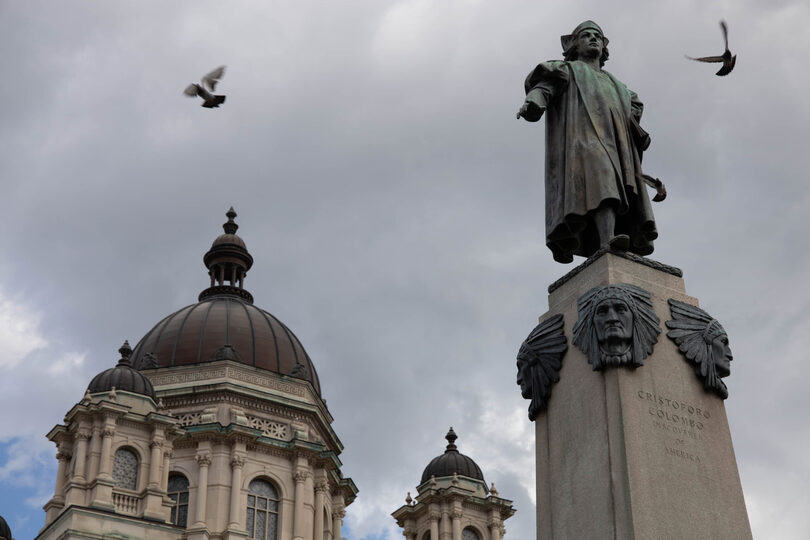A year after ruling to keep city Columbus statue, local groups file to support removal

The statue of Christopher Columbus stands in downtown Syracuse near the Onondaga County court house in Columbus Circle. Mayor Ben Walsh announced plans to remove the statue in 2020, but was faced with a lawsuit from the Columbus Monument Corporation, and now, local organizations WISH CNY and NOON have filed in support of Walsh. Daily Orange File Photo
Get the latest Syracuse news delivered right to your inbox.
Subscribe to our newsletter here.
In March 2022, New York State Supreme Court Justice Gerard Neri issued a ruling to keep Syracuse’s Christopher Columbus statue standing in downtown Syracuse. Now, a year later, local community organizations have filed amicus briefs to support Mayor Ben Walsh’s plan to remove the monument.
The ruling was a result of the Columbus Monument Corporation’s May 2021 lawsuit challenging Walsh’s decision to remove the statue. Two organizations, the Women of Italian and Syracuse Heritage and Neighbors of the Onondaga Nation, filed an amicus brief on March 15 showing their support for Walsh’s decision to appeal Neri’s ruling.
WISH CNY and NOON both requested to appear before the court to argue in support of removing the statue– although it was originally meant to honor Italian American heritage and achievement, it now represents colonization and violence, the two groups maintain in the brief.
CMC, a local group which advocates in favor of keeping the statue as a symbol of heritage and art, first filed a lawsuit against Walsh and the city of Syracuse in May 2021 contending that Walsh did not have the authority to remove the statue because the Syracuse Common Council had not approved the action.
The Council of Presidents of Major Italian American Organizations filed an amicus brief in the winter on behalf of CMC. In March 2022, Neri ruled in favor of CMC, but the Onondaga Nation filed an amicus brief in the appellate court to have their arguments on the matter heard.
The statue, originally erected in 1934, is located in the Columbus Circle of downtown Syracuse across from the Carnegie building and the Onondaga County Courthouse.
Local community organizations have spoken out about the harm the statue symbolizes. Joe Heath, general counsel for the Onondaga Nation, said the statue’s historical significance has changed since its creation to represent colonialism, white supremacy and systemic oppression.
“Syracuse is a refugee city. There are over 50 languages spoken in one of the high schools,” Heath said. “This is not the city that it was in 1934.”
Walsh first announced plans to remove and eventually replace it with a heritage site in October 2020 during a national reckoning with racial inequity following George Floyd’s murder by Minneapolis police earlier the same year.
“This decision is based on the fact that we can honor our Italian American community without focusing on a statue that has become the source of division over decades and overshadowed the original intent of the monument,” Walsh said at the time.
Heath said that as the lawyer for the Onondaga Nation, he hoped the lawsuit would result in removal of the statue as has been the case in several other cities. After the height of the Black Lives Matter protests sparked by Floyd’s murder, at least 33 Columbus monuments have been removed across the United States as of September 2020, CBS reported.
Heath likened the symbolism of Columbus statues to that of Confederate statues, saying both serve as icons of racism and white supremacy.
“We really need to have a broad based community dialogue about white supremacy and systematic racism,” Heath said. “If we don’t admit these historic harms, and begin to understand what they’ve meant to the victims, we can’t move together positively the way we could.”
When Walsh announced his plans in 2020, he stated the monument would be moved to an undetermined, private location. He also said he planned to rename Columbus Circle and build a heritage commemoration site – including a fountain and obelisk – in the circle dedicated specifically to Italian Americans, as well as to Indigenous communities, Black Americans, immigrants and other marginalized groups.
In October 2020, Walsh created the Columbus Circle Action Committee, which included members of InterFaith Works CNY, a non-profit focused on building relationships between different religious communities, and volunteers, to help him reach a decision on the future of the statue in Syracuse.
Blake Garland-Tirado, a Syracuse University alumnus, began a Change.org petition in 2020 to ask for the removal of the monument. In the petition, Garland-Tirado wrote that the monument represents the racist and violent removal of Indigenous peoples from their ancestral lands. The petition has accumulated over 18,900 signatures in support of the statue’s removal as of March 21.
“There is power in a symbol. While we meet our local governments with demands to reform police and end unjust killings of indigenous people, we must also eliminate the symbols that allow us to view the most racist act of violence in our nation’s history in a heroic light,” Tirado wrote in the petition.
Garland-Tirado, along with hundreds of community members and representatives from organizations, led protests against the statue throughout 2020. Community members have continued to protest about the monument and Neri’s ruling.
Danielle Smith, a member of the Resilient Indigenous Action Collective, said at a March 2022 protest that the lawsuit process has been difficult to experience, yet necessary.
“It just gets prolonged and prolonged,” Smith said of the legal process for the monument’s removal at the protest.
“Whether anybody agreed that this was what should be done in 1934 or not is really irrelevant, because hopefully we’ve learned a little since 1934, particularly in terms of systematic white supremacy and racism, and that’s the underlying issue in this matter,” Heath said.
Asst. News Editor Kendall Luther and Asst. Digital Editor Neil Vijayan contributed reporting to this article.





